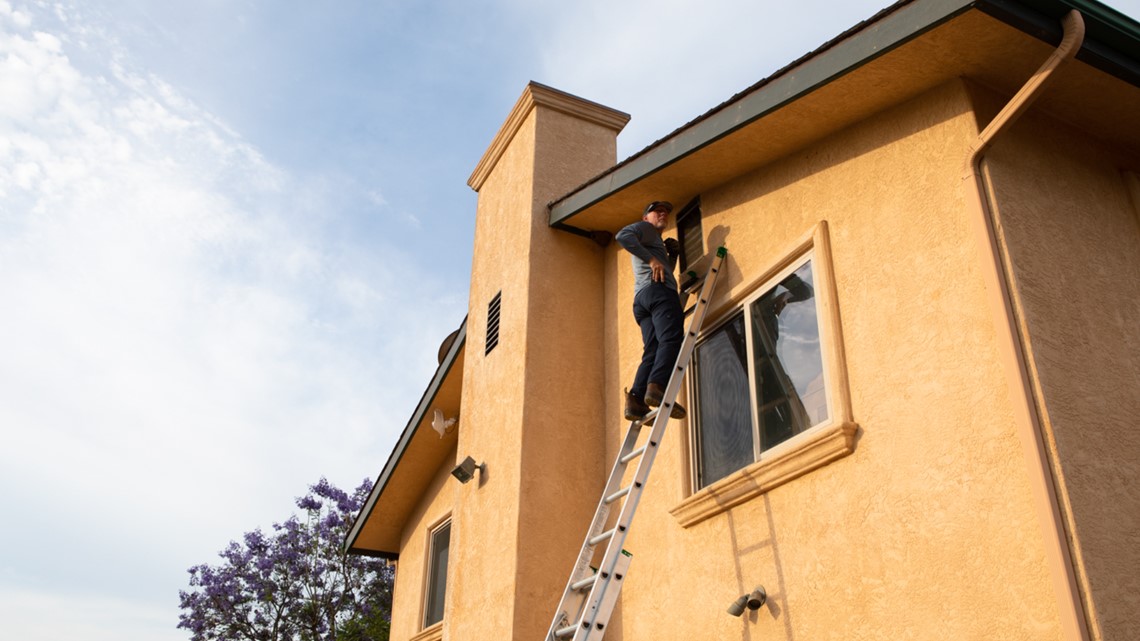SAN DIEGO COUNTY, Calif. — On a recent June morning, David Ross stood on his hilltop property overlooking the San Vicente Reservoir about four miles north of Lakeside and recalled the fist-sized embers of the 2003 Cedar Fire that burned down his house as he and his family fled for their lives.
Nearby, workers were climbing to the roofline of his rebuilt home to install ember-resistant attic vents designed to prevent airborne cinders from flying inside through ventilation openings.
“We’re paranoid about fire around here,” said Ross, who is paying for his vent upgrades with money from San Diego Gas & Electric, which provides up to $2,428 to homeowners along the Sunrise Powerlink transmission line who buy and install the vents.
“After you're burned out one time, you're pretty alert,” he said. “You're pretty aware.”
The vents are widely recommended as a way to guard homes against wildfires because they help protect against burning embers, which can fly up to a mile away or more from their origin and are responsible for the destruction of most homes in a wildfire.


The San Diego County Board of Supervisors acknowledged the value of vents in fire prevention in June 2019, when the board unanimously approved a $1.5 million grant project to help backcountry households buy and install ember-resistant vents. At least 66,200 households would have been eligible for the grants, according to the county’s estimate. The county fire agency said the program, which aimed to serve homeowners outside the Sunrise Powerlink area, was “an opportunity to directly save lives and property.”
But before any money could be spent, the reimbursement program was abandoned. Last November, county fire officials told the supervisors that they wanted to spend the money on other fire prevention strategies, blaming an inability to find someone to run the program and predicting homeowners’ lack of interest in partial reimbursements for vents.
The county’s abandonment of the vents program last year was news to Palomar Mountain homeowner Yvonne Vaucher, who recently said she had been waiting for the vent reimbursement program to appear since first hearing about it and didn’t know the money had been spent elsewhere.
As the president of the Palomar Mountain Fire Safe Council, Vaucher helps educate her community, which would have been eligible for the grants, about fire safety.
“It's one of the thoughts you always have … you know? Will your house be there in a month?” she said about the area’s high fire risk.
She said installing the vents can cost people a lot of money.
“It would be helpful if there was a program to help people do it. But if you can possibly do it, it's definitely worthwhile because it will help save your house,” she said.


inewsource asked Board of Supervisors Chair Nathan Fletcher and Supervisor Jim Desmond, whose district includes areas that would have benefited from the vent program, whether the county should have pulled the plug on the program so soon. The two supervisors were the only ones on the board last year when that decision was made.
Neither agreed to an interview nor answered the question in statements provided by their aides. Fletcher said in a statement he hoped to see an increase in fire staffing in the upcoming budget.
Last week, county and state officials met to discuss starting another pilot program with state, federal and local funds to help low income and socially vulnerable homeowners harden their homes, county spokesperson Donnie Ryan said.
Fire officials blame lack of interest
The diversion of the money once set aside for vent reimbursements comes as state leaders push home upgrades as one strategy for preventing devastating property losses in the wake of record-breaking California wildfires. According to scientists, wildfires are growing more frequent and severe as a result of climate change and fire suppression policies that have led to the build -up of brush, dead limbs and other plant materials that fuel the fires.
In April, Gov. Gavin Newsom and state lawmakers announced the passage of $25 million in financial assistance for home hardening as part of a $536 million special funding package for wildfires. The program takes effect in January.
The interest in that money could be great. In San Diego County, roughly 88% of the population and around 1 million homes are exposed to some wildfire hazard, according to a 2018 county report. That includes almost 78,000 homes in high to extreme fire hazard areas.
The county vents program would have provided ember-resistant vents to homeowners in parts of east and north San Diego County, targeting regions at high risk for fires that are excluded from the Sunrise Powerlink program funded by SDG&E. Popular forested communities, including Palomar Mountain, Mount Laguna and Julian, would have been helped.
How to upgrade to ember-resistant vents
Cal Fire recommends you cover vent openings with a 1/16-inch to 1/8-inch metal mesh and use ember- and flame-resistant vents.
The California State Fire Marshal lists three companies whose products meet its standard for wildland urban interface vents.
Check out all the home retrofits recommended by Cal Fire at readyforwildfire.org, including low-cost options.
From 2018 through 2020, the Sunrise program has helped about 600 homeowners upgrade their vents. The county could have served more than twice that — about 1,300 — if eligible homeowners in the highest priority areas claimed the maximum reimbursement. For those homes, the county would have reimbursed up to 50% of the cost, maxing out at $1,150.
In January 2020, the county sought a contractor to establish the program, promote it, conduct outreach to identify eligible homeowners, and manage applications and reimbursements. But fire officials said they failed to get any bids.
Officials also said potential contractors thought the program, which only called for partial reimbursements, would draw too few participants.
Fire officials were authorized to spend the $1.5 million elsewhere, so they did.
Dave Nissen, a Cal Fire deputy chief who leads the county’s community risk reduction division, said his main focus was providing safe evacuation corridors.
“The vents are absolutely very valuable to the protection of your home, but at the same time, ember vents alone aren’t what make a survivable structure,” Nissen told inewsource. “In the fire environment, it's the total package of things.”


Around a third of the money once slated for vents has now been spent, primarily on the $360,000 purchase of two masticators to help chew up brush along roads. The first one was scheduled to arrive this month.
Some of the remaining money is expected to go toward mailing out custom evacuation guides and other informational materials. Around $200,000 is expected to expand the Knox Box program, which provides emergency responders access to spare home keys in a box affixed to homes and has been lauded by county officials as a success.
Michele Clock, the community risk reduction program manager for the San Diego County Fire Protection District, is credited with coming up with the idea for the vents reimbursement project. She said in redirecting the vents money, staff made a calculation based on how they could have the most impact.
“We decided that that funding could be better used towards these other programs that could benefit ... a lot more people,” she said.
SUBHED: Vents rising in popularity
Kelly Berkompas, the co-founder of Brandguard Vents, was disappointed the county program did not gain traction. It was her company that installed the vents at David Ross’ Lakeside home under the SDG&E program.
“That is sad if that is the only reason they didn’t do it,” she said, referring to the lack of bids on the county’s proposal.
Berkompas said she gave county officials information about the costs of vents when they reached out about two years ago about the program they were putting together. Her Orange County-based company is one of the three listed by the state fire marshal as meeting California’s fire standards.
She said she didn’t know San Diego County had trouble drumming up interest and could have recommended people to run the program. Her company makes the vents but also handles installation, she said, and could have run the program or been used as a vendor.
She also said business spiked during the pandemic as people invested in home projects.


“We are definitely swamped right now,” Berkompas said, adding her company’s products are installed in homes daily in San Diego County with help from the Sunrise Powerlink grants.
The SDG&E grants fund ember-resistant vents, other forms of structure hardening and the clearing of brush from homes to create defensible space. SDG&E agreed to provide about $2.8 million a year in grants as a condition of getting approval to build the 117-mile Sunrise Powerlink transmission line.
The program has prioritized spending on vent reimbursements, offering a near-automatic approval process and extending the application period to encourage participation. A program spokesperson said the grants typically cover the cost of purchasing and installing the vents.
Jim Courter, the president of the Greater Valley Center Fire Safe Council, said he hopes the takeaway from the county’s failed project is that more effort should be put into informing people about the benefit of ember-resistant vents. He’s a contractor who has installed them, and said he doesn’t think many homes have had retrofits to protect against fire.
“It needs more daylight,” Courter said. “It needs more education. It needs emphasis that it’s not getting.”
inewsource is a nonprofit, independently funded newsroom that produces impactful investigative and accountability journalism in San Diego County. Learn more at inewsource.org.



